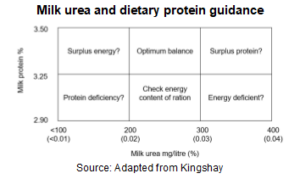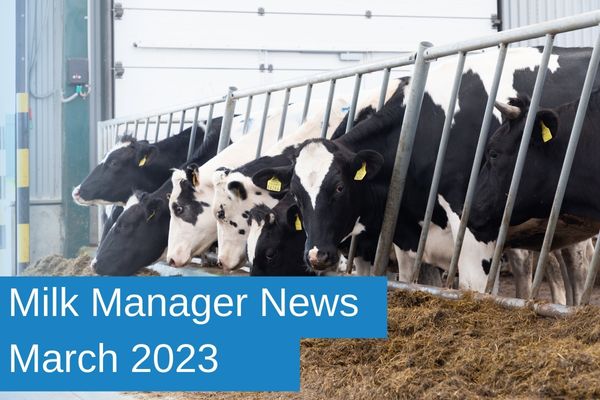Milk Manager News March 2023 – Efficient Feeding of Protein
10 March 2023Cows are very inefficient converters of dietary nitrogen (N) into milk, with an approximate efficiency of converting feed N into milk ranging anywhere from 22-33%. The efficiency of N use increases as the dietary protein content reduces and so there has been a lot of interest in reducing the crude protein content of dairy diets in order to improve the efficiency of dietary protein use and reduce N excretion to the environment. Overfeeding protein quite often will not give any performance benefit and is costly. In addition, many protein concentrates tend to have higher CO2 emissions associated with them, compared to cereals and by-products, and so feeding a lower protein diet can help contribute towards a lower carbon footprint.
Over the years, crude protein levels in dairy diets have been reduced from the norm of 18%+ and many farmers are now working with 16% diets (on a dry matter basis) without any reduction in milk output compared to when higher protein diets were fed. Crude protein refers the total protein supplied in the diet rather than just what the cow requires. Therefore, cows do not have a requirement for a percentage of protein in the diet. Rather, they require a supply of both rumen degradable protein (RDP) to form microbial protein (MP) and undegradable (bypass) protein, which combined makes up metabolisable protein. This is the protein available for use within the cow for maintenance, growth, pregnancy and lactation.
Rations high in grass and grass silage which have a high crude protein content can be difficult to balance, without leading to an oversupply of RDP. They require starchy concentrates to supply plenty of rumen available energy to the rumen bugs. This allows the rumen bugs to utilise the nitrogen produced from the rapid breakdown of RDP in grass (and grass silage) to synthesise microbial protein. Oversupplying RDP has an energy cost and excessive levels can increase the rate of body condition loss in early lactation.
With lower protein diets around 16% or slightly less, there is a good chance that methionine is deficient. Methionine is an essential amino acid for dairy cows and is the 1st limiting amino acid, with a deficiency impacting on milk yield and milk protein content. It also has a role in improving liver function and immunity and so is becoming an increasingly used addition to transition cow diets. Benefits include improved energy status around calving and in early lactation, with less risk of ketosis, improved immune status and better milking performance.
Milk urea can give crude indicator as to whether protein supply is adequate (see following diagram). If milk urea is low (below 0.02% or 200mg/litre it can indicate a lack of RDP in the diet, or an excess of rumen fermentable energy (from starchy cereals or sugar sources such as molasses). If low milk urea is also accompanied by low milk protein percentage, it is likely that RDP is deficient. If milk urea is high, then either there is an excess of RDP and/or insufficient rumen available energy to help utilise excess protein. If high milk urea is accompanied by low milk protein, then it is more likely a result of energy deficiency. In this situation cows are more likely to be mobilising body reserves and lose more condition in early lactation.
The muck will also give an indication of protein supply – if it is too loose there could be an excess of RDP and if it is on the stiff side, or there is present undigested feed e.g., grain or forage particles greater than 0.5 inch long, there is likely a lack of RDP which can restrict rumen function and feed conversion efficiency.
When working with low crude protein diets of 16% or slightly less, the inclusion of rumen protected methionine may benefit milk yield and milk protein percentage. Given the current high feed costs, it is worth reviewing the milking cow diet to see if savings can be made in protein supplementation in conjunction with an up-to-date forage analysis.
lorna.macpherson@sac.co.uk; 07760 990901
Sign up to the FAS newsletter
Receive updates on news, events and publications from Scotland’s Farm Advisory Service


